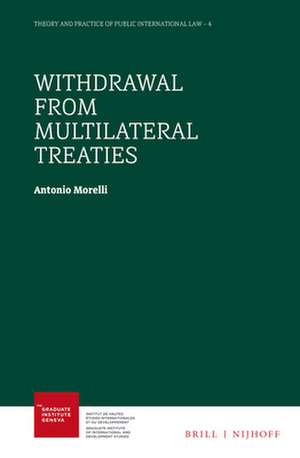Withdrawal from Multilateral Treaties: Theory and Practice of Public International Law, cartea 4
Autor Antonio Morellien Limba Engleză Hardback – 6 oct 2021
Preț: 666.20 lei
Preț vechi: 812.44 lei
-18% Nou
Puncte Express: 999
Preț estimativ în valută:
127.48€ • 131.51$ • 106.38£
127.48€ • 131.51$ • 106.38£
Carte indisponibilă temporar
Doresc să fiu notificat când acest titlu va fi disponibil:
Se trimite...
Preluare comenzi: 021 569.72.76
Specificații
ISBN-13: 9789004467613
ISBN-10: 9004467610
Dimensiuni: 155 x 235 mm
Greutate: 0.54 kg
Editura: Brill
Colecția Brill | Nijhoff
Seria Theory and Practice of Public International Law
ISBN-10: 9004467610
Dimensiuni: 155 x 235 mm
Greutate: 0.54 kg
Editura: Brill
Colecția Brill | Nijhoff
Seria Theory and Practice of Public International Law
Notă biografică
Antonio Morelli is an SJD graduate of American University Washington College of Law who specializes in international law and governance.
Cuprins
Foreword
Preface
Acknowledgments
Abbreviations
Table of Documents
Table of Cases
List of Figures
1 The Legal Framework of Withdrawal from Multilateral Treaties
Introduction
I. Understanding Withdrawal
A. Definition of Withdrawal
B. The Progressive Codification of Withdrawal
C. Withdrawal as an Expression of States’ Voluntarism
II. Withdrawal in International and Domestic Law
A. Withdrawal in General International Law
B. Withdrawal in the Vienna Convention on the Law of Treaties
C. Withdrawal in Domestic Law
D. The Limits of Legal Formalism and the Way Forward
2 Conceptualizing Withdrawal
Introduction
I. Analyzing Withdrawal through the Lens of Commitment and Compliance in International Treaties
A. Shifting Balances from Compliance to Commitment in Times of Withdrawal
B. Withdrawal and Commitment: Two Sides of the Same Coin
C. Differences between Withdrawal and Breach
II. Analyzing Withdrawal through the Lens of Risk Management
A. Risk Management in International Treaties
B. Risk in Treaty Making and Treaty Maintenance
III. Analyzing Withdrawal through the Lens of the Principle Pacta Sunt Servanda
A. From Cooperative to Noncooperative Outcomes
B. Lawfulness and Cooperativeness of Withdrawal
3 The Evolution of Withdrawal
Introduction
I. From Unity to Disengagement in the International Legal Order
A. The Concept of Unity
B. International Legal Theory and the Treaty-Making Process
II. Quantitative Study on Withdrawal
A. Defining the Population of Interest and the Goals
B. Empirical Results
4 Categories of Withdrawal
Introduction
I. International Tribunals and Committees
A. The International Court of Justice
B. The International Criminal Court
C. The UN Human Rights Committee
II. International Organizations
A. United Nations
B. UN Agencies
C. International Financial Institutions
D. Brexit and Regional Organizations
III. High-Profile International Commitments
A. Agreements Derogating from Norms of Jus Cogens
B. Arms Control Agreements
C. Climate Change Agreements
IV. Withdrawing from the Agreement, Remaining in the Regime
V. Signatory Withdrawal
5 Rationales for Withdrawal
Introduction
I. Withdrawal as a Reaction in Domestic Politics
A. Economic Costs
B. Expansion of Jurisdiction (“Mission Creep”)
C. Perception of Bias or Unfairness
II. Withdrawal as an Act of State Power
A. Shift in Domestic Political Leadership
B. Leverage for Amending a Treaty
C. Defense Strategy
D. Alternative Consensus
6 Regulating and Enhancing Orderly Withdrawal from Multilateral Treaties
Introduction
I. International Solutions
A. Securing Commitment through Withdrawal Procedure
B. Enhancing Commitment through International Regimes
II. Domestic Solutions
A. Regulating Domestic Treaty-Making Power
B. Socializing Commitment through a Multi-Stakeholders’ Approach
Conclusion
Appendix: Table of Withdrawals
Bibliography
Index
Preface
Acknowledgments
Abbreviations
Table of Documents
Table of Cases
List of Figures
1 The Legal Framework of Withdrawal from Multilateral Treaties
Introduction
I. Understanding Withdrawal
A. Definition of Withdrawal
B. The Progressive Codification of Withdrawal
C. Withdrawal as an Expression of States’ Voluntarism
II. Withdrawal in International and Domestic Law
A. Withdrawal in General International Law
B. Withdrawal in the Vienna Convention on the Law of Treaties
C. Withdrawal in Domestic Law
D. The Limits of Legal Formalism and the Way Forward
2 Conceptualizing Withdrawal
Introduction
I. Analyzing Withdrawal through the Lens of Commitment and Compliance in International Treaties
A. Shifting Balances from Compliance to Commitment in Times of Withdrawal
B. Withdrawal and Commitment: Two Sides of the Same Coin
C. Differences between Withdrawal and Breach
II. Analyzing Withdrawal through the Lens of Risk Management
A. Risk Management in International Treaties
B. Risk in Treaty Making and Treaty Maintenance
III. Analyzing Withdrawal through the Lens of the Principle Pacta Sunt Servanda
A. From Cooperative to Noncooperative Outcomes
B. Lawfulness and Cooperativeness of Withdrawal
3 The Evolution of Withdrawal
Introduction
I. From Unity to Disengagement in the International Legal Order
A. The Concept of Unity
B. International Legal Theory and the Treaty-Making Process
II. Quantitative Study on Withdrawal
A. Defining the Population of Interest and the Goals
B. Empirical Results
4 Categories of Withdrawal
Introduction
I. International Tribunals and Committees
A. The International Court of Justice
B. The International Criminal Court
C. The UN Human Rights Committee
II. International Organizations
A. United Nations
B. UN Agencies
C. International Financial Institutions
D. Brexit and Regional Organizations
III. High-Profile International Commitments
A. Agreements Derogating from Norms of Jus Cogens
B. Arms Control Agreements
C. Climate Change Agreements
IV. Withdrawing from the Agreement, Remaining in the Regime
V. Signatory Withdrawal
5 Rationales for Withdrawal
Introduction
I. Withdrawal as a Reaction in Domestic Politics
A. Economic Costs
B. Expansion of Jurisdiction (“Mission Creep”)
C. Perception of Bias or Unfairness
II. Withdrawal as an Act of State Power
A. Shift in Domestic Political Leadership
B. Leverage for Amending a Treaty
C. Defense Strategy
D. Alternative Consensus
6 Regulating and Enhancing Orderly Withdrawal from Multilateral Treaties
Introduction
I. International Solutions
A. Securing Commitment through Withdrawal Procedure
B. Enhancing Commitment through International Regimes
II. Domestic Solutions
A. Regulating Domestic Treaty-Making Power
B. Socializing Commitment through a Multi-Stakeholders’ Approach
Conclusion
Appendix: Table of Withdrawals
Bibliography
Index





